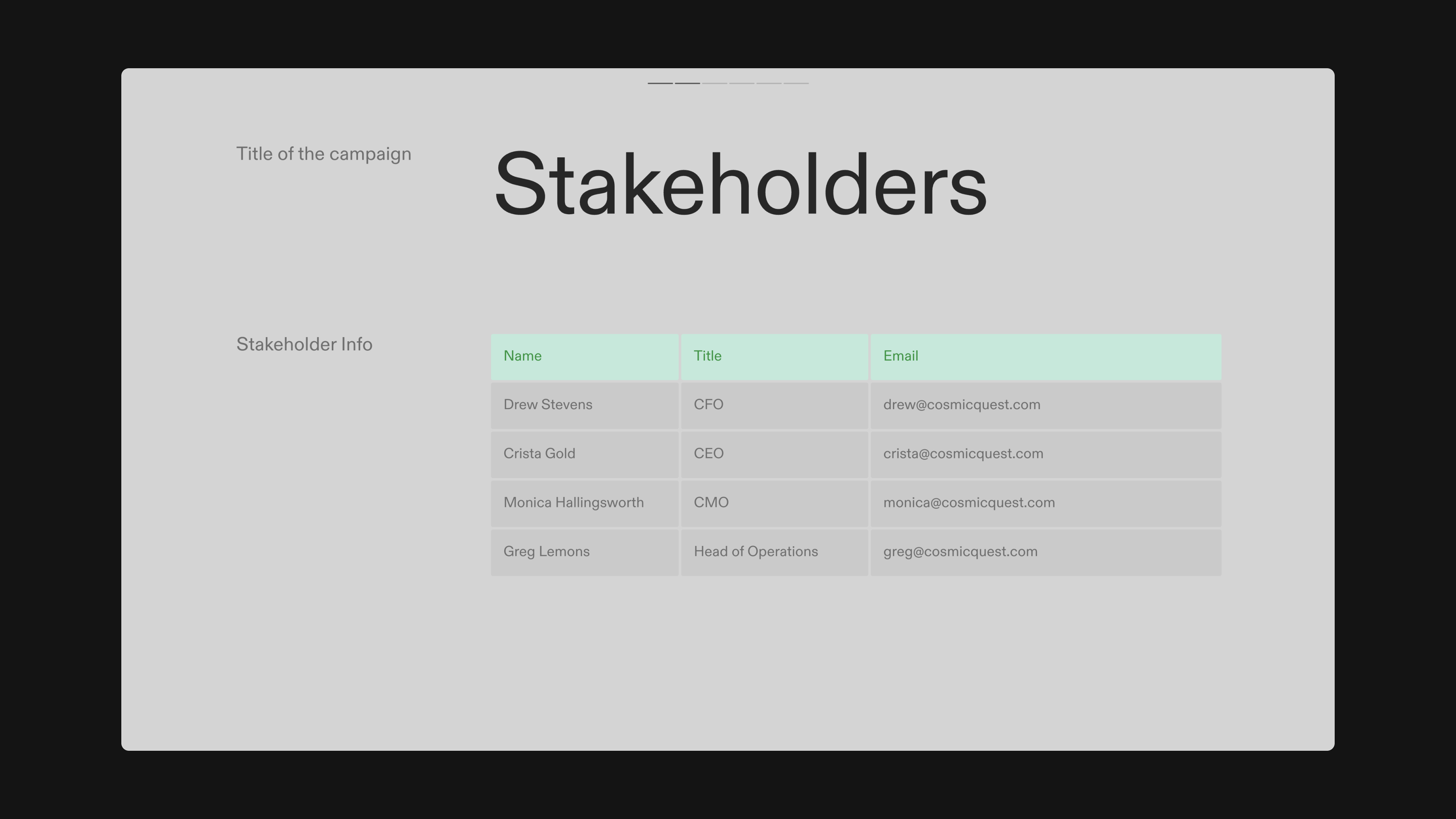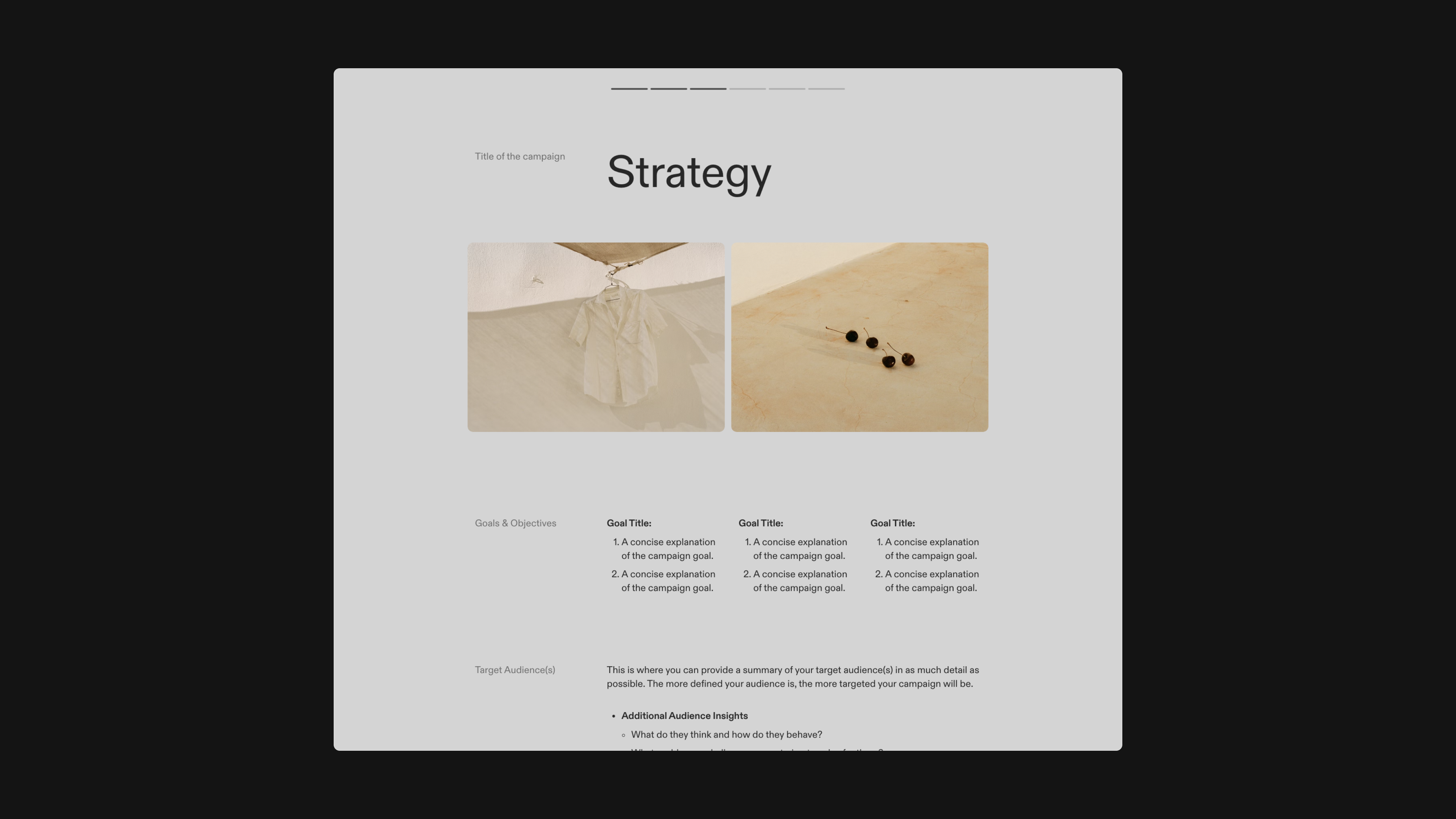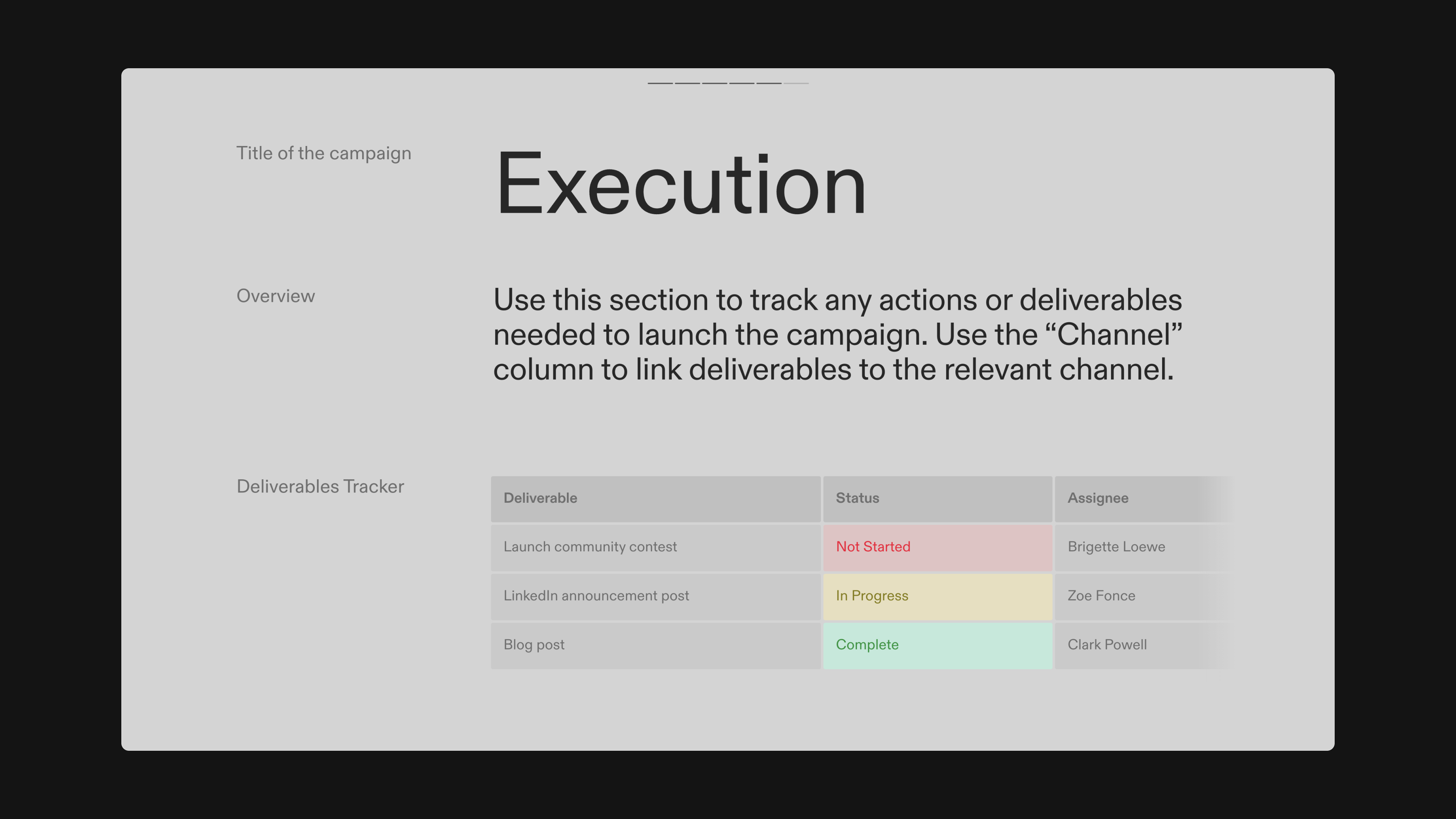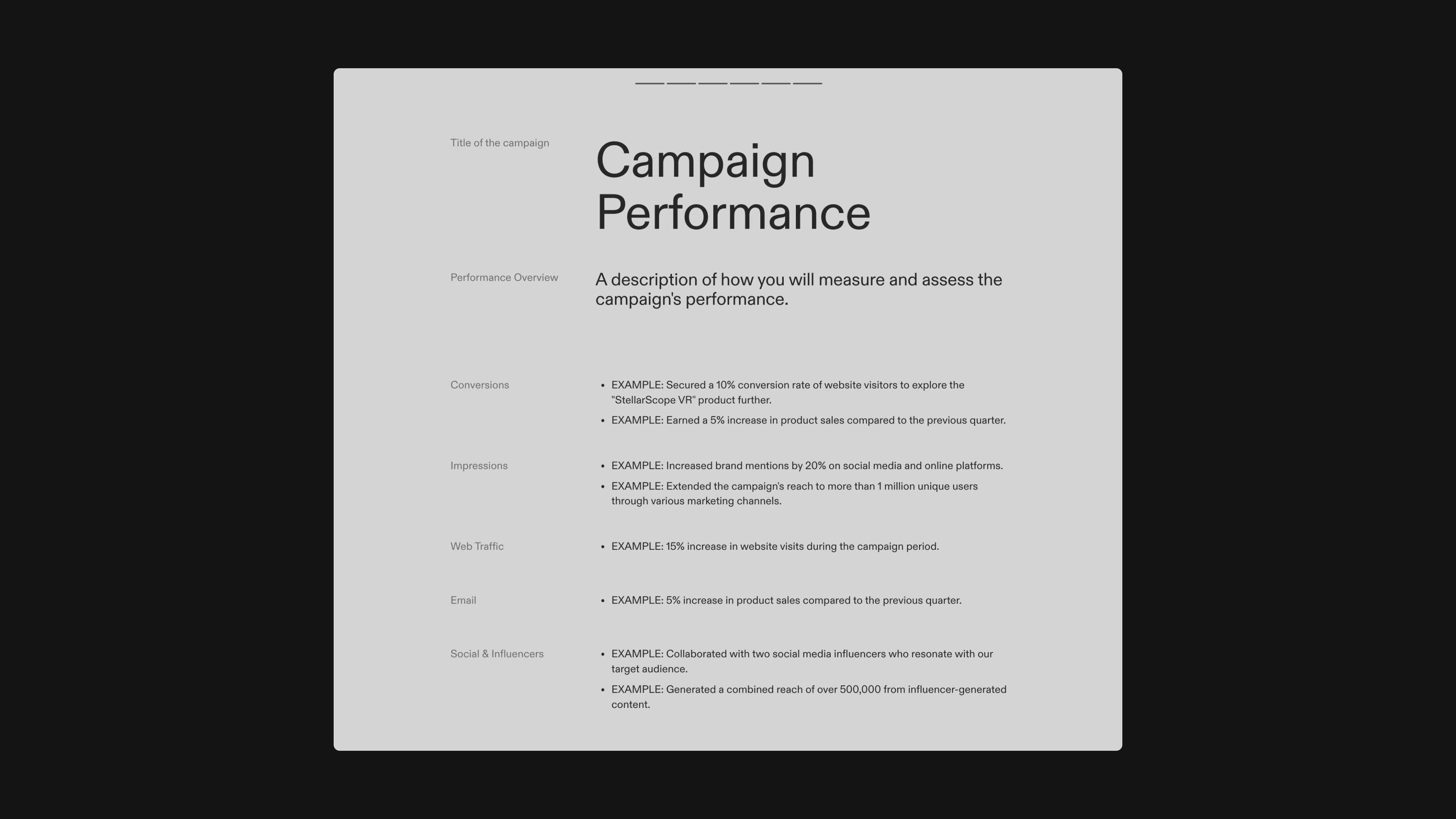Tips of the trade
How to Write an Effective Marketing Brief
Marketing briefs serve as a roadmap to success for marketing initiatives and campaigns, outlining the creative and deployment plan for all stakeholders.

As important as inspiration or enthusiasm are impactful marketing strategies, they are supported by far simpler practices: planning and documentation. Compiling details into a single source of truth allows all that inspiration and enthusiasm to be expressed exactly as you’ve intended.
The best way to do that is to write a marketing brief, a key touchpoint for marketing teams and their collaborators.
What is a marketing brief?
A marketing brief is a document that provides an overview of the various components and deadlines within a marketing campaign. Marketing teams write marketing briefs usually to serve a dual purpose:
- Roadmap for the marketing team. Briefs are an essential roadmap that provides the foundation for a campaign, keeping the marketing team grounded and working harmoniously to the benefit of the campaign itself, and avoiding the need to make major decisions midstream.
- Reference for stakeholders. Briefs serve as a reference for internal team members involved in the campaign, as well as any executive stakeholders or external clients who may not be involved in the day-to-day execution but require visibility.
Marketing brief vs. creative brief
Marketing briefs and creative briefs are close cousins, but they focus on different things and usually have different audiences. Creative briefs guide the development of creative assets—imagery, videos, and the like—while marketing briefs detail the deployment plan for those creative assets within a campaign.
7 Key elements of a marketing brief
What distinguishes a marketing brief from a glorified checklist? A combination of details, insight, and timing. In essence, good storytelling. Many of the elements in a standard brief are technical—capturing where and when certain pieces will be put into play—but the overall effect is a symphonic view of all the working parts.
Your marketing brief should include the following seven items.
1. Campaign title and description
Will the right name help kickstart your creative flow? Absolutely—but a campaign title is about more than a catchy moniker: it keeps your team on the same page and prevents confusion for anyone who might need to refer to the campaign during its various phases. Titles can be straightforward (“Spring/Summer Capsule 2023”) or cheeky (“World Domination”), and in most cases are for internal use only. When it’s time to share the campaign with the world, you’ll have another chance to give it an externally-facing name for media outlets to reference.
If your campaign is being created for an external stakeholder such as a client, this is a good place to provide background about their brand, especially as it relates to the campaign. Is this the first time your company, or your client, is doing something like this? If so, why? What is the overarching concept or story behind the campaign? Was it inspired by, or in response to, notable events or trends in your industry? Try to capture these contextual details around the product or service at the center of your campaign in a concise paragraph or bulleted list.

2. Campaign objectives
Next, identify the agreed-upon goals and objectives behind the campaign. Campaign objectives can be broad (“increase brand awareness”) as well as specific (“increase engagement by 10%), and elements of the campaign should tie back to these goals. Aim to provide a concise summary for each stated goal, along with any anticipated key performance indicators (KPIs) you plan to track. You’ll cover these in more detail in the final performance-related pages of your brief.
3. Stakeholder overview

Stakeholders, those internal team members who are intimately involved in the campaign or will have final sign-off, are a critical piece of any marketing brief. Reserve a spot in your document to list any appropriate names alongside their position, contact information, and project roles and responsibilities.
4. Strategy overview

Your campaign strategy should include an overview of your target audience and target market, that captures their demographic information, buying habits, and pain points, as well as the value propositions that address them. You’ll also want to outline the feelings you hope to elicit from your target audience, and the actions you want them to take as a result. These should map back to the objectives you established in the previous section.
Strategy in a marketing brief also contains messaging-specific dos and don’ts, like a list of key takeaways and talking points. If you’re launching a new product, which features do you plan to spotlight? Outlining these priorities, as well as any other considerations or guidelines, like style notes or press embargoes, also means your messaging stays consistent across the team. This may become important if multiple people will be sourcing talent or connections from their own networks.
5. Channel breakdown

Channel strategy is all about the “where” of your campaign, mapping how it will be distributed across multiple channels. This breakdown should include owned channels, like on-site blog posts and social media pages, as well as digital channels, broadcast channels like TV, podcasts, and radio, in-person events, along with device targeting or prioritization.
Don’t worry about detailing out individual social media posts, here; the goal is to provide an overview of your guiding strategy for each channel, and the key moments that will serve as anchors throughout the campaign.
6. Execution plan

Next, chart any major deliverables, budget parameters, and flight dates on a timeline for at-a-glance alignment, listing project managers and teams responsible for each piece.
7. Measurement plan

You already established campaign objectives and the high-level KPIs you’ll use as assess, but this is where you dive into the details of how you’ll measure campaign performance. If the goal is total sales, this will be relatively straightforward, but if the goal is brand awareness, how do you plan to measure it? Outline what you (or your client) should expect to see once the campaign has ended, or what analysis you plan to do post-mortem.

How to write an effective marketing brief in 5 essential steps
You’ve ironed out all the details of your great idea, and now it’s time to create a marketing brief that can be shared team-wide. The goal of a marketing brief, as stated above, is alignment, but it is also about efficiency: a well-written brief ideally eliminates repetitive questions about the campaign or its stages from team members with varying degrees of involvement.
This doesn’t mean your brief needs to be an exhaustive cache of answers, but it should give anyone reading it a strong sense of the impulses behind the campaign as well as the activation.
Here’s a step-by-step guide to building an effective, well-rounded marketing brief:
1. Identify your audience
The first step to any marketing exercise is understanding your target audience, and with good reason: identifying who exactly you’re trying to reach will inform how and where you reach them.
Crafting buyer personas can be an effective way to condense all the relevant information like age, purchasing personality, income, and values into short, digestible paragraphs perfect for a brief format. Buyer personas are also easier to visualize for many people, and can help to communicate the reach of your campaign quicker and with less uncertainty.
2. Research the competitive landscape
Once you have a handle on your audience, it’s time to assess your positioning in the competitive landscape. What are the differentiating factors, and how can you use them to your advantage throughout your campaign? This strategic exercise may inform which creative content or channels you prioritize, and you should be prepared to speak to those decisions in your brief.
3. Define plan and evaluate strategy
A great marketing strategy illuminates the connection between a problem and its proposed solution, and this relationship should be woven throughout your marketing brief, from the project description all the way through to how you plan to assess your results. Make sure to incorporate the creative strategy and details about asset usage into your brief, and gather input from all necessary stakeholders.
4. Map the project timeline
Once the plan has been greenlit, it’s time to compile a timeline for launch. This will require coordinating between various contributors to establish a realistic schedule of deliverables and necessary rounds of approval behind each component. For example, if you plan to go live with an announcement video on social media by a certain date, establish a work back schedule to identify the ideal deadlines for any creative components of the announcement.
5. Audit for style and tone
Even if you only plan to share your marketing brief internally, it should align with brand voice and tone. Imbue your copy with humor or expertise or passion when appropriate; doing so will infuse all the details and mechanics with meaning, and make for a more compelling document to refer back to.
Make great marketing briefs with Tome
Tome’s marketing brief template allows you to chart every aspect of your marketing campaign in an elegant, easy-to-navigate interface designed for collaboration. With dynamic, customizable layouts and responsive tables and trackers, you can keep things high-level or dive into the minutia without sacrificing the flow of information. Tap into Tome’s AI-powered narrative guidance to tighten up project descriptions and talking points.
You may also like...

Three popular ways to use AI in sales training, including materials creation, role-playing, and personalized coaching.

Show potential clients and partners who you are and what you can do in Tome.